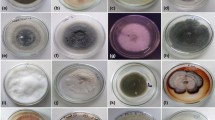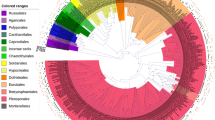Abstract
Psychrophilic microorganisms are cold-adapted organisms that have an optimum growth temperature below 15 °C, and often below 5 °C. Endophytic microorganisms live inside healthy plants and biosynthesize an array of secondary metabolites which confer major ecological benefits to their host. We provide information, for the first time, on an endophytic association between bioactive psychrophilic fungi and trees in Cupressaceae plant family living in temperate to cold, semi-arid habitats. We have recovered psychrophilic endophytic fungi (PEF) from healthy foliar tissues of Cupressus arizonica, Cupressus sempervirens and Thuja orientalis (Cupressaceae, Coniferales). In total, 23 such fungi were found out of 110 endophytic fungal isolates. They were identified as ascomycetous fungi, more specifically Phoma herbarum, Phoma sp. and Dothideomycetes spp., all from Dothideomycetes. The optimal growth temperature for all these 23 fungal isolates was 4 °C, and the PEF isolates were able to biosynthesize secondary metabolite at this temperature. Extracted metabolites from PEF showed significant antiproliferative/cytotoxic, antifungal and antibacterial effects against phytopathogenic fungi and bacteria. Of special interest was their antibacterial activity against the ice-nucleation active bacterium Pseudomonas syringae. Accordingly, we suggest that evergreen Cupressaceae plants may benefit from their psychrophilic endophytic fungi during cold stress. Whether such endosymbionts confer any ecological and evolutionary benefits to their host plants remains to be investigated in vivo.
Similar content being viewed by others
References
Abbasi M, Aliabadi F (2009) The list of fungi recorded in proceedings of 12th to 18th Iranian plant protection congresses (1995–2008). Elm va Honar Press, Iran, 276
Abdollahzadeh J, Mohammadi Goltapeh E, Javadi A, Shams-Bakhsh M, Zare R, Phillips AJL (2009) Barriopsis iraniana and Phaeobotryon cupressi: two new species of the Botryosphaeriaceae from trees in Iran. Persoonia 23:1–8
Aly AH, Debbab A, Kjer J, Proksch P (2010) Fungal endophytes from higher plants: a prolific source of phytochemicals and other bioactive natural products. Fungal Divers 41:1–16
Barnett HL (1960) Illustrated genera of imperfect fungi. Burgess Publishing company, Minneapolis, pp 225
Boerema GH, Gruyter J, de Noordeloos ME, Hamers MEC (2004) Phoma identification manual. Differentiation of specific and infra-specific taxa in culture. CABI Publishing, 470
Del Frate G, Caretta G (1990) Fungi isolated from Antarctic material. Polar Biol 11:1–7
Deming JW (2002) Psychrophiles and polar regions. Curr Opin Microbiol 5:301–309
Domsch KH, Gams W, Anderson TH (1980) Compendium of soil fungi. Academic, London
Ershad, J (2009) Fungi of Iran. Iranian Research Institute of Plant Protection Press. 3rd Eds, 531
Flanagan PW, Scarborough AM (1974) Physiological groups of decomposer fungi on tundra plant remains. In: Holding AJ, Heal OW, McLean SF Jr, Flannagan PE (Eds) Soil organisms and decomposition in tundra. Tundra Biome Steering Committee, Stockholm, pp 159–181
Fralish JS, Franklin SB (2002) Taxonomy and ecology of woody plants in North American forests. Wiley, New York
Frisvad JC (2008) Fungi in cold ecosystems. In: Margesin R, Schinner F, Marx JC, Gerday C (Eds) Psychrophiles: from biodiversity to biotechnology, vol 9, Chapter., pp 137–156
Gocheva YG, Krumova E, Slokoska L, Gesheva V, Angelova M (2005) Isolation of filamentous fungi from Antarctica. C R Acad Bulg Sci 58:403–408
Gounot AM (1986) Psychrophilic and psychrotrophic microorganisms. Experientia 42:1192–1197
Hoffman MT, Arnold AE (2008) Geographic locality and host identity shape fungal endophyte communities in Cupressaceous trees. Mycol Res 112:331–334
Hoffman MT, Arnold AE (2010) Diverse bacteria inhabit living hyphae of phylogenetically diverse fungal endophytes. Appl Environ Microbiol 76:4063–4075
Hosseyni Moghaddam MS (2013) Study on some biological effects of natural products from endophytes of cypress. MSc thesis, Bu-Ali Sina University of Hamedan, Iran, 180
Hosseyni Moghaddam MS, Soltani J (2013) An Investigation on the effects of photoperiod, aging and culture media on vegetative growth and sporulation of rice blast pathogen Pyricularia oryzae. Prog Biol Sci 3:135–143
Hosseyni Moghaddam MS, Soltani J (2014) Bioactivity of endophytic Trichoderma fungal species from the plant family Cupressaceae. Ann Microbiol 64:753–761
Hosseyni Moghaddam MS, Soltani J, Babalhavaeji F, Hamzei J, Nazeri S, Mirzaei S (2013) Bioactivities of endophytic Penicillia from Cupressaceae. J Crop Prot 2:421–433
Hsiang T, Matsumoto N, Millett SM (1999) Biology and management of Typhula snow molds of turfgrass. Plant Dis 83:783–798
Huston AL (2008) Biotechnological aspects of cold-adapted enzymes. In: Margesin R, Schinner F, Marx JC, Gerday C (Eds)Psychrophiles: from biodiversity to biotechnology, pp 347–363
Kobayashi H, Namikoshi M, Yoshimoto T, Yokochi T (1996) A screening method for antimitotic and antifungal substances using conidia of P. oryzae, modification and application to tropical marine fungi. J Antibio 49:873–879
Kour A, Shawl AS, Rehman S, Sultan PH, Qazi PH, Suden P, Khajuria RK, Verma V (2008) Isolation and identification of an endophytic strain of Fusarium oxysporum producing podophyllotoxin from Juniperus recurva. World J Microbiol Biotechnol 24:1115–1121
Kumaran RS, Muthumary J, Hur BK (2008) Production of taxol from Phyllosticta spinarum, an endophytic fungus of Cupressus sp. Eng Life Sci 8:438–446
Kusari S, Lamshoft M, Spiteller M (2009) Aspergillus fumigatus fresenius, an endophytic fungus from Juniperus communis L. Horstmann as a novel source of the anticancer pro-drug deoxypodophyllotoxin. Appl Microbiol 107:1364–5072
Kusari S, Hertweck C, Spiteller M (2012) Chemical ecology of endophytic fungi: origins of secondary metabolites. Chem Biol 19:792–798
Kusari S, Pandey SP, Spiteller M (2013) Untapped mutualistic paradigms linking host plant and endophytic fungal production of similar bioactive secondary metabolites. Phytochemistry 91:81–87
Lindow SE (1983) The role of bacterial ice nucleation in frost injury to plants. Annu Rev Phytopathol 21:363–384
Margesin R, Miteva V (2011) Diversity and ecology of psychrophilic microorganisms. Res Microbiol 162:346–361
Morris CE, Sands DC, Vinatzer BA, Glaux C, Guilbaud C, Buffière A, Yan S, Dominguez H, Thompson BM (2008) The life history of the plant pathogen Pseudomonas syringae is linked to the water cycle. ISME J 2:321–334
Pitt JI, Hocking AD (1997) Fungi and food spoilage, 2nd edn. Blackie, London
Robinson CH (2001) Cold adaptation in Arctic and Antarctic fungi. New Phytol 151:341–353
Ryan R, Ryan D, Dowling DN (2007) An acquired efflux system is responsible for copper resistance in Xanthomonas strain IG8. FEMS Microbiol Lett 268:40–46
Ryan R, Germaine K, Dowling DN (2008) Bacterial endophytes: recent developments and applications. FEMS Microbiol Lett 278:1–9
Selbmann L, de Hoog GS, Mazzaglia A, Friedman EI, Onofri S (2005) Fungi at the edge of life: cryptoendolithic black fungi from Antarctic desert. Stud Mycol 51:1–32
Singh SM, Puja G, Bhat DJ (2006) Psychrophilic fungi from Schirmacher Oasis, East Antarctica. Curr Sci 90:1388–1392
Singh LP, Gill SS, Tuteja N (2011) Unraveling the role of fungal symbionts in plant abiotic stress tolerance. Plant Signal Behav 6:175–191
Soltani J, Hosseyni Moghaddam MS (2014a) Antiproliferative, antifungal and antibacterial activities of endophytic Alternaria species from Cupressaceae. Curr Microbiol 69:349–356
Soltani J, Hosseyni Moghaddam MS (2014b) Diverse and bioactive endophytic Aspergilli inhabit Cupressaceae plant family. Arch Microbiol. doi:10.1007/s00203-014-0997-8
Steel RGD, Torrie JH, Dicky DA (1997) Principles and procedures of statistics- a biometrical approach, 3rd edn. McGraw Hill Book International Co, Singapore, pp 204–227
Strobel G, Daisy B, Castillo U, Harper J (2004) Natural products from endophytic microorganisms. J Nat Prod 67:257–268
Vincent WF (1988) Microbial ecosystems of Antarctica. Cambrige University Press, Cambridge
Vishniac HS (1996) Biodiversity of yeast and filamentous microfungi in terrestrial Antarctic ecosystems. Biodivers Conserv 5:1365–1378
White TJ, Bruns T, Lee S, Taylor J (1990) Amplification and direct sequencing of fungal ribosomal RNA genes for phylogenetics. In: Innis MA, Gelfand DH, Sninsky JJ, White TJ (eds) “PCR protocols: A guide to methods and applications”. Academic, San Diego, pp 315–322
Zhang D, Yang Y, Castlebury LA, Cerniglia CE (1996) A method for the large scale isolation of high transformation efficiency fungal genomic DNA. FEMS Microbiol Lett 145:261–265
Acknowledgments
We appreciate generous gift of target fungi and bacteria by Jafar Abdollahzadeh (Kurdistan University, Sanandaj, Iran), Salar Jamali (Guilan University, Rasht, Iran) and Abolghasem Ghasemi (Plant Protection Institute, Tehran, Iran). We also thank Javad Hamzei, Freydoun Babalhavaeji, Soheila Mirzaei, Sonbol Nazeri, Dustmorad Zafari and Mohammad-Javad Soleimani Pari at Bu-Ali Sina University of Hamedan, Iran, for their helpful discussions and for sharing laboratory facilities. This work was financially supported by BABiNT, and a grant from BASU to J.S. Jalal Soltani dedicates this work to Mohammad Reza Soltani and Javad Soltani.
Author information
Authors and Affiliations
Corresponding author
Additional information
Mahdieh S. Hosseyni Moghaddam and Jalal Soltani contributed equally to this work.
Electronic supplementary material
Below is the link to the electronic supplementary material.
Table S1
(DOCX 18 kb)
Rights and permissions
About this article
Cite this article
Hosseyni Moghaddam, M.S., Soltani, J. Psychrophilic endophytic fungi with biological activity inhabit Cupressaceae plant family. Symbiosis 63, 79–86 (2014). https://doi.org/10.1007/s13199-014-0290-2
Received:
Accepted:
Published:
Issue Date:
DOI: https://doi.org/10.1007/s13199-014-0290-2




